Health issues smothered by wealth concerns – medical education is the casualty
RN Bhaskar
On 22 September the country’s leading publications stated that the National Medical Commission (NMC) had barred Tamil Nadu from adding any new medical seats (https://www.hindustantimes.com/india-news/nmcs-new-guidelines-may-have-adverse-impact-on-tamil-nadu-experts-101695756143484.html).
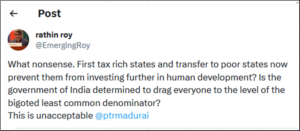 The result was an uproar. It was clear that the NMC was trying to throttle the common man and squeeze education out of existence. Twitter (now known as X) had many venting their ire.
The result was an uproar. It was clear that the NMC was trying to throttle the common man and squeeze education out of existence. Twitter (now known as X) had many venting their ire.
Said Rathin Roy, economist, “What nonsense. First tax rich states and transfer to poor states now prevent them from investing further in human development. Is the government of India determined to drag everyone to the level of the bigoted least common denominator? This is unacceptable.” (https://twitter.com/EmergingRoy/status/1706276969099268123).
Ohers, like Dr. Sudhir Kumar, were more guarded in their expression (https://twitter.com/hyderabaddoctor/status/1706168087043780832). But the anger was palpable. Other publications like South First, took the case even further by stating that “New NMC guidelines won’t allow new medical colleges in many states in South India” (https://thesouthfirst.com/health/new-nmc-guidelines-wont-allow-new-medical-colleges-seats-in-any-states-of-south-india/).
The NMC was clearly at fault. In its Gazette notification No. U. 1102213/2023-UGMEB dated 16 August 2023 (the notification can be downloaded from https://www.nmc.org.in/rules-regulations/national-medical-commission-minimum-standard-requirments-for-establishment-of-new-medical-college-increase-of-seats-in-mbbs-course-guidelines-2023-reg/ or even from here), it stated that “After A Y. 2023-24, Letter of permission (LOP) for starting of new medical colleges shall be issued only for annual intake capacity of 50/ I 00/150 seats — Provided that medical college shall follow the ratio of 100 MBBS seats for 10 lakh population in that state.” That meant having a ratio of just 1 medical seat for every 10,000 people.
Clearly, the NMC has willy nilly ventured into state politics instead of promoting medical education. It wants to ensure that each state has its fair share of the much-coveted medical seats. But in doing so, the NMC has damned the entire country. Effectively, it is telling people that other countries can increase their medical seat capacity, but some Indian states won’t be allowed to. It was a dog-in-the-manger policy, aimed at damning the entire nation.
Consider two tables, from the government’s own statements before the Rajya Sabha on 9 February 2022 Can be downloaded from https://www.mea.gov.in/rajya-sabha.htm?dtl/36215/QUESTION_NO861_STUDENTS_STUDYING_ABROAD or from here.
What the first table shows is that 7.5 lakh students went overseas for education because Indian universities offered neither the quality nor the subjects, nor even the seats they wanted. Therefore, many students flock to Russia (or to Ukraine before the war). They still go to China for medical studies – China has around 25,000 medical students enrolled in its universities.
China’s case is interesting because it has created the best of universities and colleges which offer courses in English. The best of doctors from all over the world (even from India) go there to teach students – both Chinese and foreign. China’s fees for a five-year programme inclusive of boarding and lodging would be under Rs.25 lakh – in India the capitation fee alone is around Rs.1-5 crore. China admits only the brightest of students. In fees low, it has avoided the elitist approach of the US and UK which charge very high fees. China is thus like many European countries which believe that education costs should be kept low so that patient care costs are also kept low. This way, it gets the best of students, even those from not very affluent homes. It uses the talent for its hospitals and workplaces, and even ensures a social equilibrium that USA and UK (even India) have lost sight of.
RBI and forex outgo
By not creating additional seats, India has only hurt itself. It helps other countries create jobs, makes their respective economies more vibrant as they charge foreign students for everything. That drains India’s foreign exchange reserves.
At a conservative estimate, India should be losing around Rs.7,5 lakh crore (or 7.5 trillion) each year. This is because each student should be spending, on an average, around Rs. 1 crore annually. That translates into USD 88 billion each year (at a conversion rate of Rs.85 to one USD). Even if one discounts this figure by half, it still means an outgo of USD 44 billion annually. The NMC proposals will thus further pauperise India.
RBI’s official figures on education forex outgo appear a lot more modest. In a reply to an RTI query (No. RBIND/R/E/23/00856 – Shri R N Bhaskar dated March 1, 2023), the RBI said that during 2021-22 the total forex outgo on account of education was USD 5.12 billion! And the forex outgo during April 2022 to January 2023 was just Rs.2.97 billion.
Such figures defy common sense. Unless, of course, people have been paying for education without reporting it to the RBI. This could be true of children of several Indian bureaucrats and ministers who are known to get scholarships from endowments, which in turn are funded by savvy Indian businesses. It has emerged as one of the best way of bribing policy makers without ever letting anyone know that it was a bribe.
 Then go to the second table. India’s vison for education for foreigners is also warped.
Then go to the second table. India’s vison for education for foreigners is also warped.
Consider how barely 79,000 students came to India to study, compared with 7,5 lakh that went overseas. Look at a neighbouring country like Bangladesh which invited around 17,000 Indian students to study there, even while India, a larger country with more resources, could attract just 9,000 from that country. Not surprisingly, Bangladesh enjoys a per capital income which has begun to surpass India’s.
Ironically, India even tells some of its universities not to enroll foreign students. It also restricts universities from charging foreign students higher fees in much the same way universities in UK and US do.
India seems determined to make foreign countries prosper by bankrupting itself.
In the case of medical education, the situation is sad. The full list of how many medical seats each state has can be downloaded from (URL)
First, consider the states which have more medical seats compared to their respective populations – in excess of the norms suggested by the NMC.
These are states or union territories which have more medical seats — for less than 10,000 people. Also notice that except for Sikkim, there is no North Indian state which has invested in medical education. Such findings are in sync with Lok Sabha figures on school education (free subscription — https://bhaskarr.substack.com/p/the-state-of-education-in-india).
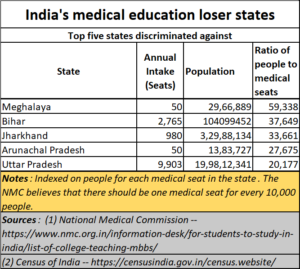 Then look at the loser states. They too show that the worst performers in terms of GER (gross enrolment ratio), internet enabled classrooms and even schools with science laboratories are from the Hindi belt. Clearly, in spite of a lot about chest thumping about being Vishwa gurus (teachers to the world), India’s policy makers in North India have scant respect for educating the masses.
Then look at the loser states. They too show that the worst performers in terms of GER (gross enrolment ratio), internet enabled classrooms and even schools with science laboratories are from the Hindi belt. Clearly, in spite of a lot about chest thumping about being Vishwa gurus (teachers to the world), India’s policy makers in North India have scant respect for educating the masses.
Naturally, states with the worst medical seat to population ratios come from such states.
It is surprising that at least two North-Eastern states, which have pretty decent educational standards in primary and secondary school education, have fallen into this category. This could be a case of the centre not allocating enough funds to them.
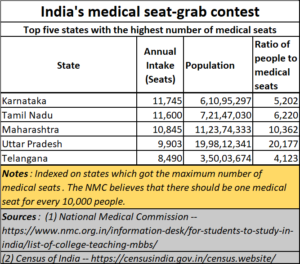 Finally, consider states that have the largest number of medical seats (though not necessarily as a ratio of population).
Finally, consider states that have the largest number of medical seats (though not necessarily as a ratio of population).
But there is another way to look at this. These are the states that contribute the largest funds to the government by way of taxes. They provide the best standards of living. They have the least unemployment rates. They, therefore, have a duty to fulfill the aspirations of their people to better education.
By preventing well-performing states from having more medical seats, the NMC is trying to throttle their growth. It is a beggar-they-neighbour approach that can only harm India. Such shortsighted policies of the NMC should be stopped immediately.
So, what should NMC do?
Ideally, NMC should have discussed this with educationists and social scientists before pushing out the gazette notification. But this has become typical of a government that prefers to shoot first and ask questions later. It did that with the import ban on computers, women reservation bill, demonetisation, the three farm Bills . . . The list is long.
But here are some suggestions for NMC
- Retain the clauses on the infrastructure requirements but add a clause on the need to measure outcomes. It should have a common exit exam – like the GRE — for all graduating students. Students who flunk this examination, cannot be given certificates to practice medicine. It will take away much of the discrepancy in standards between the performance of reserved seats students and the open category students.
- Measurement of outcomes is imperative. It tells the government which medical schools have the least failures. And also, which schools have the highest number of failing students. Publish the list of the best and worst performing schools.
- Warn poorly performing schools. If the poor performance continues for two years, take control of the management of the school and hospital away from such (poorly performing) authorities and transfer them to (willing) managements of the best performing schools. This will make the worst schools perform better, else the school now gets to be managed by better performing managements.
- Do not seek to shut down schools in a resource scarce country, contrary NMC’s directives (https://indianexpress.com/article/education/nmc-releases-msme-regulations-2023-medicalcolleges-could-be-fined-up-to-rs-1-crore-for-non-compliance-8963084/). NMC states in ‘Maintenance of Standards of Medical Education Regulations, 2023’ that it will withdraw accreditation for a period of five years. This is akin to a ban which Indian policy makers love. Instead, work like a merchant banker, taking a distressed asset from the hands of a poor manager by transferring it to a better manager.
- Ensure proper facilities and excellent teachers without being bureaucratic about degrees and experience. Permit professionals to become visiting faculty. In the past managements of medical colleges discouraged practicing professionals from teaching at their institutes. When China and the USA can do this, why can’t India?
- Do not regulate the number of schools. If India has ten times the number of medical colleges, and if they are well run, India will create more doctors, and will also become the centre for medical education for foreign students.
- As the number of colleges increases, the competition will bring down the high rates of capitation fees, or donations. Merit and competition will do what the government has not been able to do.
- Devise schemes to allow backward states to set up medical colleges with government grants, but only if they can adhere to the right outcomes. That will drive away managements that seek to profiteer, without responsibility. Let there be no control on fees for the first 3-5 years. Once the numbers increase and competition becomes fierce, fees will drop automatically. Regulations on fees would become superfluous.
- Immediately scrap ill-conceived schemes like ignoring NEET scores for admission to the post graduate medical courses (MS, MS etc.). NEET is also known as National-eligibility-cum-entrance tests (https://indianexpress.com/article/explained/neet-pg-qualifying-percentile-reduced-zero-8951379). This is the first time that the eligibility cut-off has been completely done away with. As a result, as many as 86 candidates who scored 100 or less out of a total of 800 marks in the National Eligibility cum Entrance Test (NEET) (PG) were given a seat in the third round of medical counselling for the all-India quota (https://indianexpress.com/article/cities/mumbai/86-candidates-with-100-or-less-marks-inneet-pg-allotted-md-seats-8967047/). Sub-standard talent at post graduate courses will only result in more trauma for common people. The rich will always find doctors who are good. The poor must make do with doctors who are available, and still pay exorbitant fees for such diagnosis and treatment.
In other words, NMC should promote education. Not stifle it. India needs many more doctors. India needs forex too. Even states like Maharashtra have 50%of posts lying vacant in government hospitals (https://www.freepressjournal.in/mumbai/mumbai-news-empty-posts-cripple-state-health-system). Many of the measures it has been promoting go against the vision of the government’s Ayushman Bharat (a healthy India) scheme (https://asiaconverge.com/2018/08/ayushman-bharat-great-concept-doctors-overlooked/). NMCs refusal to create more doctors on a war footing is therefore an act against national interests.































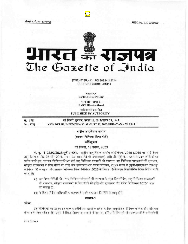
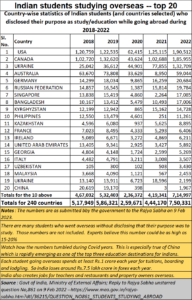
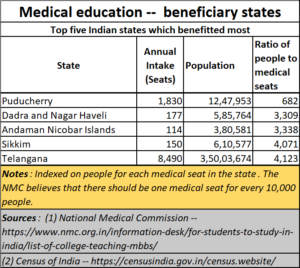







COMMENTS